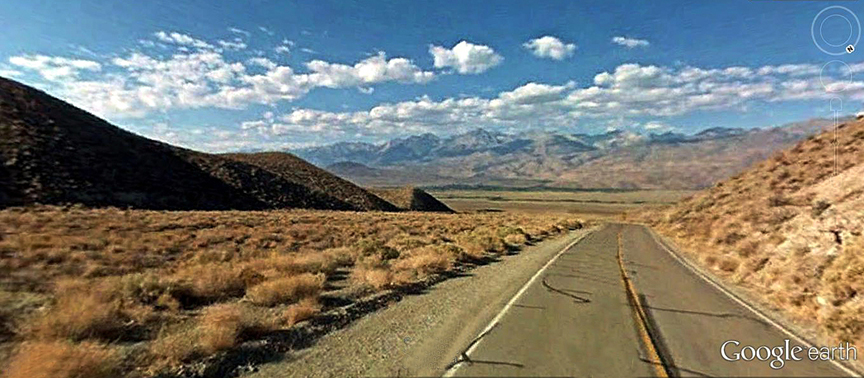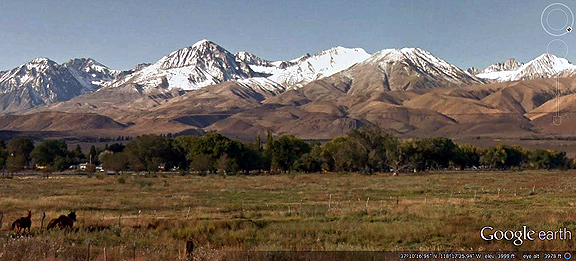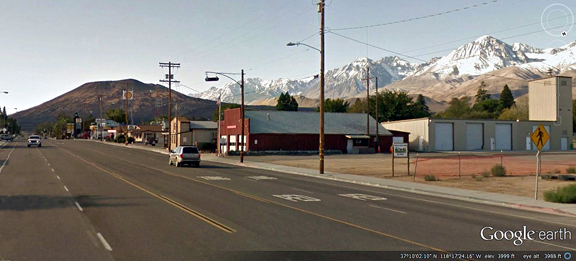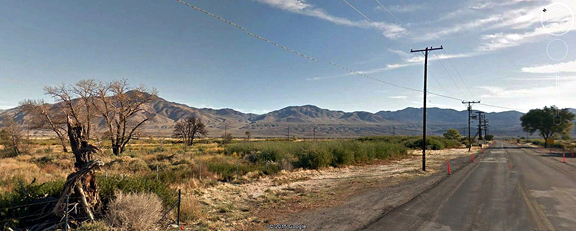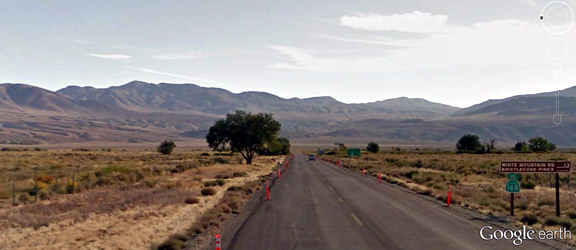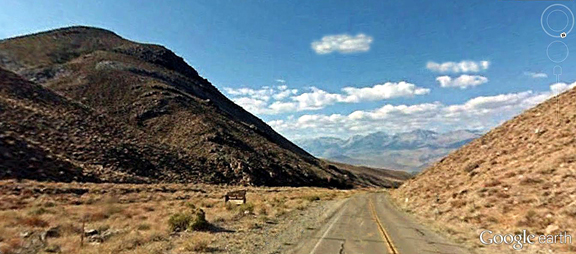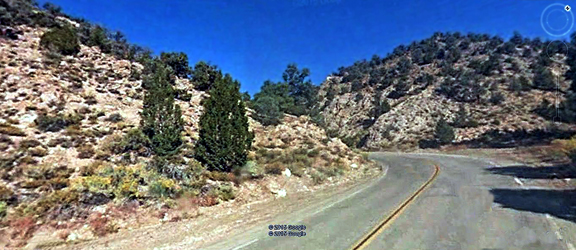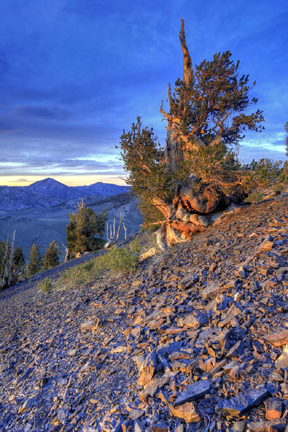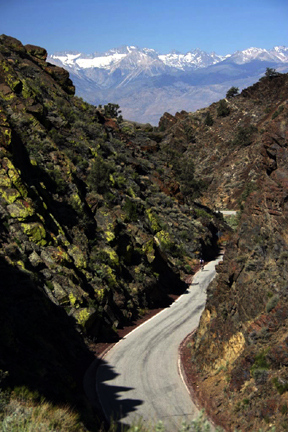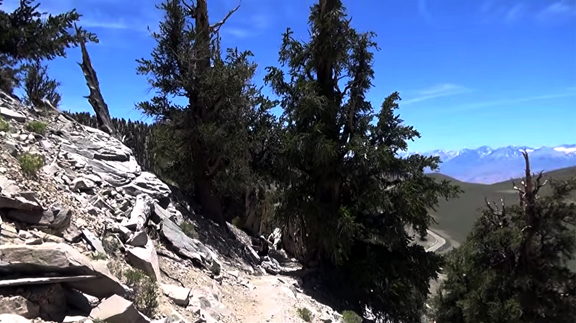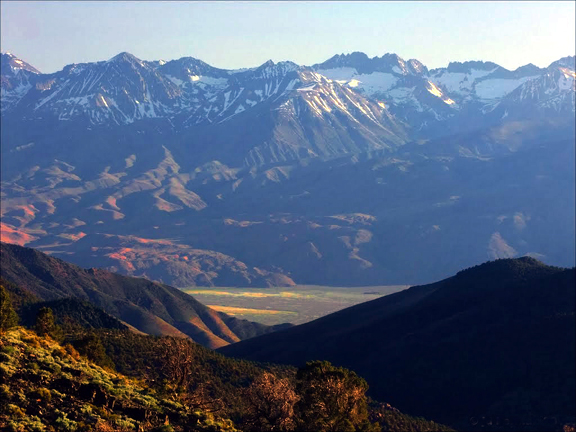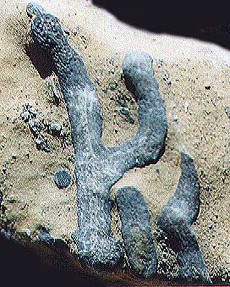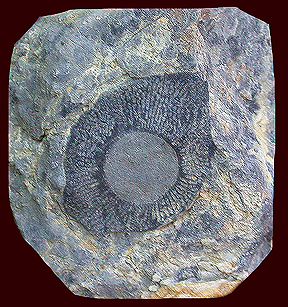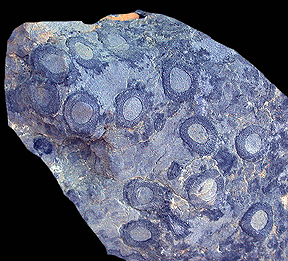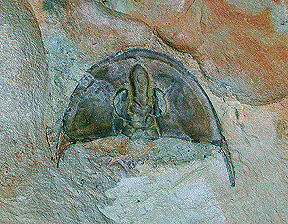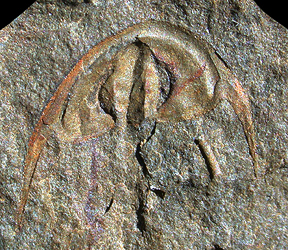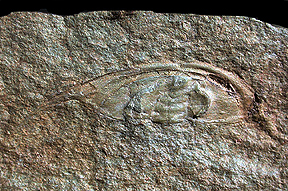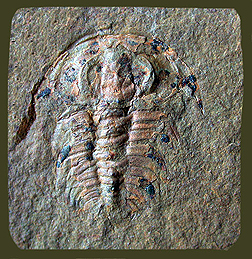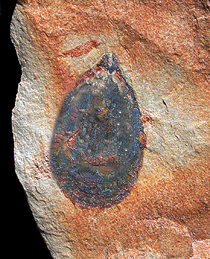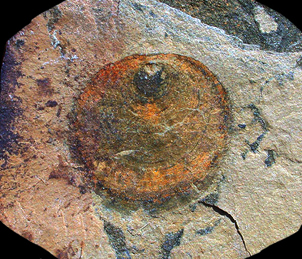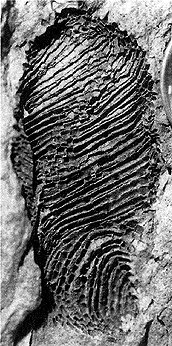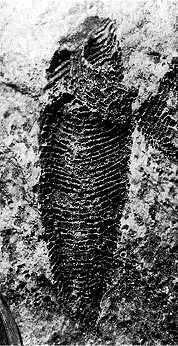|
Many species of plants and animals have become extinct
throughout the geologic past. Ammonites, trilobites, and dinosaurs
are among the more familiar types whose vanished representative
lineages now famously reside within the rocks of the earth's
crust. Still, despite the fact that such sensational, long-lived
species died out, the larger grouping or classification of animals
to which they belonged continues to survive to this date. The
ammonite, for example, was a cephalopod mollusk--rather distantly
related to our modern day chambered nautilus; the trilobite,
in turn, belonged to a scientific phylum called Arthropoda, a
phylum that includes such successful relatives as insects, crabs,
crustaceans, and spiders; and the dinosaurs of course were vertebrate
animals, whose backboned kinds are very much alive and well.
While each of the above-listed creatures became extinct
for varying paleobiological reasons, the broader category, or
phylum to which they belonged has survived. And, as far as paleontologists
can determine, virtually all the major groups of animals present
during the dawn-age Cambrian Explosion of approximately 535 to
510 million years ago, when there occurred a phenomenal, unprecedented
radiation of biological diversification, are still alive today--despite
the fact that capricious culling periodically eliminates innumerable
species throughout geologic time.
A notable exception to this pattern of persisting phylum
survival is the paleontological occurrence of curious critters
paleontologists call salterella and Volborthella. They're
invertebrate animals exclusive to the early Cambrian that secreted
conical to ice cream cone-shaped shells roughly a quarter inch-long
long; and they're now placed into their own unique phylum called
Agmata, a phylum that went belly-up, extinct, approximately 510
million years ago--among only a select few of the major taxonomic
categories of animals ever to vanish completely, leaving no discernible
descendants or relatives.
To put this in perspective, the extinction of an entire
phylum such as Agmata is analogous to having all the corals,
for example, disappear from our oceans--or, every animal with
a backbone suddenly gone forever. By all speculative accounts,
this was a terribly traumatic event in the history of our planet.
Prime hunting grounds for Agmata small shelly fossils include
the Great Basin wilds of western to central Esmeralda County,
Nevada.
Yet another fascinating animal preserved in rocks exclusively
of early Cambrian geologic age is the enigmatic archaeocythid,
an invertebrate type that along with Agmata salterella-Volborthella
and Olenellid trilobites thrived in earth's warm shallow
seas roughly 528 to 510 million years ago. Although those creatures
never survived the early Cambrian age, only the Agmata represent
a complete, unique phylum that went extinct. Olenellid trilobites
and archaeocythids belong to the living phyla Arthropoda and
Porifera (the sponges), respectively.
Still and all, not too many years ago a consensus of invertebrate
paleontologists considered archaeocyathids members of their own
unique Phylum called Archaeocyatha, preferring to count them
among the select few phyla ever to go belly-up, to vanish forever
with no known modern biological affinity.
The archaeocyathid was an exclusively marine invertebrate
animal that never survived beyond the early Cambrian of the Cambrian
Period; it goes absent from the geologic record around 510 million
years ago. Yet, during a life span of perhaps "only"
18 million years (roughly 528 to 510 million years) it was able
to attain worldwide distribution while developing into scores
of different species. In morphological aspect, an archaeocyathid
has been variously described as a peculiar cross between a coral
and a sponge. White it admittedly reveals obvious similarities
to both, it is in fact decidedly different in many key delineating
comparisons.
Pioneering early Cambrian investigators separated almost
immediately into two warring camps over the exact zoological
classification of the archaeocyathid. That is to say: just where
exactly should one place the animal--is it a coral or sponge?
Some paleontologists argued in favor of the coral category (see
the classic 1868 publication "On a remarkable new genus
of corals" in American Journal of Science, 2nd service,
volume 46, pages 62-64), while others--the majority opinion,
actually--vociferously proclaimed that it most closely resembled
a sponge; hence the ubiquitous, "endearing" term "pleosponge"
came about to describe the archaeocyathid, a designation still
found in many older textbooks on invertebrate paleontology.
Although it's true that both battling camps could adduce
compelling evidence to support their views, all the controversy
occurred before any serious analysis of the archaeocyathid was
undertaken. When some especially well preserved specimens were
finally examined with that proverbial fine-toothed comb, paleontologists
came to the conclusion that, yes, while the archaeocyathid did
show apparent similarities to both corals and sponges, it was
indeed sufficiently different from coral coelenterates and typical
Porifera to warrant placement in a new, separate phylum--then
known as Archaeocyatha.
That zoological classification of archaeocyathids as a
distinct, unique phylum lasted for several decades. When somebody
named a new species of archaeocyathid, the official peer-reviewed
scientific paper in which the formal description appeared always
placed an archaeocyathid type specimen within the phylum Archaeocyatha.
In recent years, though, rigorous cladistic phylogenetic analysis
nests archaeocyathids pretty convincingly among the Porifera--the
sponges; more specifically, it is now usually considered an extinct
calcareous sponge--the first shell-secreting member of the phylum
Porifera to appear during the Cambrian Explosion, and the very
first known sponge to go extinct, disappear completely from the
geologic record.
Since the actual archaeocyathid soft-bodied animal has
never been found preserved, researchers base their conclusions
concerning the creature on study of the available fossil shell
material. The archaeocyathid secreted a conical to cup-shaped
calcium carbonate structure typically half an inch to three inches
longs, and one-eighth to one inch in diameter. A few aberrant
species can reach a foot or more in length, however. Some varieties
in the class Irregularia began to sport wildly radiating, branching
shell designs, a feature which distinguishes them from all other
kinds of archaeocyathids. Most, though, retained their conical,
elongated configuration right up to the end of their reign. Apparently
the creature led a sessile life attached to the sea floor; some
types sometimes formed minor reef-like communities. As a matter
of fact, it seems to have been the very first Cambrian Explosion
shell-bearing animal to develop a quasi-reef, or biohermal structure
on the sea floor, a life-style greatly impoved upon by the corals,
which succeeded the archaeocyathid in the geologic record during
Ordovician Period times.
Typically, archaeocyathids formed "gardens" in
the shallow early Cambrian seas, parallel to the ancient coastlines,
where they probably fed by filtering for microscopic plants and
animals, similar to the habits of present day sponges, corals,
bryozoans, brachiopods, and barnacles. Their shell was extremely
fragile--it is indeed miraculous that we have as many complete
specimens to study as we do--and they disdained with a passion
any degree of muddy water. It is conjectured that they reproduced
by giving rise to free-floating larvae that swan about for a
time before settling to the sea floor. Additionally noteworthy
is that sometimes seen preserved with archaeocyathids are the
remains of cyanobacterial blue-green algae, suggesting some degree
of symbiotic relationship.
All archaeocyathids became extinct by the close of the
early Cambrian, approximately 510 million years ago. They left
no discernible descendants. They remain the only major group
of sponges to leave no living representatives. In North America
and Australia, extinction of the archaeocyathids coincides with
the disappearance of Olenellid trilobites, and this leads to
the interesting idea that perhaps the two shared some kind of
symbiotic, mutually beneficial relationship, perishing in tandem
when their required conditions for life vanished. Exactly why
the archeocyathid died out is a major paleontological mystery,
much like the more notorious debate over the demise of the dinosaur.
At present, the most logical hypothesis is that the archaeocyathid,
possessing a very primitive silt filtering system, was unable
to adapt to increasingly muddy waters, that corals and siliceous
sponges were much more efficient, successful adapters in general,
and therefore were primed and ready to claim each available paleo-ecological
niche the archaeocyathid was forced to surrender. This idea finds
support in the lithology of the rocks in which fossil archaeocyathids
are today preserved: They occur almost exclusively in pure limestones
that are uncontaminated by silts or muds.
Because archaeocyathids gained worldwide distribution within
such a finite, "short" life span--around 18 million
years--they are an excellent guide fossil to the early Cambrian
geologic age. Find an archaeocyathid anywhere on the planet and
you know immediately that you are dealing with rocks dating from
the early Cambrian. Their remains have been identified from several
geographic localities, including Morocco, Sardinia, Mexico, Yukon
Territory, British Columbia, Labrador, China, Ural Mountains
of the former Soviet Union, Siberia, East Antarctica, West Antarctica,
Australia, and the United States.
In the United States, archaeocyathids occur in Alaska,
Washington state, Alabama, Georgia, Virginia, New Jersey, Pennsylvania,
New York, Nevada, and California. As a matter of fact, some of
the best archaeocyathid localities in the world occur in western
to central Nevada and eastern California. Here, sprawling across
an area encompassing hundreds of square miles in Inyo County,
California, and neighboring Esmeralda County, Nevada, lies the
land of the archaeocyathid. Most occur in a geologic rock unit
called the Poleta Formation, lower Cambrian in age of course,
a formation named for its extensive and typical exposures in
Poleta Canyon a few miles east of Bishop, California. This is
a remarkably widespread and distinctive series of strata consisting
of alternating limestones, quartzites (heat and pressure-altered
sandstone), and shales. And, in keeping with their invariable
characteristic distribution in other parts of the world, archaeocyathids
occur only in the silt-free limestones. Within the Poleta Formation,
these fossil-bearing calcium carbonate accumulations can be found
in the lowest, or oldest stratigraphic sections of exposures,
below thick deposits of Poleta greenish shales and brownish quartzites
which, while barren of archaeocyathids, are noted for locally
common Olenellid trilobites, annelid trails, and echinoderms.
These preserved archaeocyathids represent, in fact, some
of the oldest recognizable remains of animals with hard parts
from the Cambrian Explosion period, which began 535 million years
ago--a moment in geologic time some 965 million years after the
appearance of what scientific investigators now consider the
first undisputed eukaryote (a cell with a nucleus; all complex,
modern plant and animal life is eukaryotic) and only about 65
million years following the first multicellular eukaryotic animals
at roughly 600 million years ago (the earth is approximately
4.55 billion years old).
Prime hunting grounds for the fossil include western to
central Nevada and the northernmost quarter to third of Inyo
County, California. And one of the very best regions in which
to paleo-prospect for archaeocyathids lies a few miles east of
Big Pine, California, in the White-Inyo Mountains, along Westgard
Pass. The drive over State Route 168 toward Westgard Pass slices
through several thick outcroppings of the fossiliferous limestones
lowest in the Poleta Formation, within which occur locally common
to abundant remains of archaeocyathids, some in primitive reef
form.
To reach an excellent fossil-bearing area where nice specimens
of archaeocyathids can be found, first travel to Big Pine, California,
a wonderful community in the Owens Valley at the base of the
great Sierra Nevada, 15 miles south of Bishop, or 44 miles north
of Lone Pine along Highway 395. From the northern outskirts of
Big Pine along Highway 395, take State Route 168 east. But be
sure to take time to observe the striking specimen of giant sequoia
(Big Tree-Sierra Redwood) at the intersection of 395 and State
Route 168--it's The Roosevelt Tree, planted July 23, 1913 in
honor of US president Teddy Roosevelt, to commemorate the opening
of SR 168 to automobile traffic over Westgard Pass. Proceed two
and four-tenths miles to the intersection with the Death Valley-Saline
Valley Road. Recheck your mileage here, then continue onward
along SR 168.
From the junction with Death Valley-Saline Valley Road,
travel another nine and nine-tenths miles. At this point route
168 begins to cut through a "narrows" in the limestones
of the lower Cambrian Poleta Formation; the limestones here are
massive (showing indistinct layering characteristics), blue-gray
to orange-mottled, and fossiliferous with the remains of archaeocyathids.
For the next six-tenths of a mile the Poleta limestones are prominent
and easily accessible on both sides of SR 168. Find a convenient--and
safe--pullout on which to park (the road does indeed narrow considerably
here; extreme caution must be exercised), then hike to the slopes
above the road to the locally fossiliferous calcium carbonate
accumulations.
You will need to hike with assiduous attention in order
to observe the best-preserved specimens. Remember, obviously,
that lots of folks have been here before you, including innumerable
geology classes from all over the United States, Canada, and
Mexico--in addition to any number of interested amateur paleontology
enthusiasts and visiting professional paleontologists from all
over the world, as well. And so it is inevitable, then, that
everybody must indeed have their own turn at exploring these
remarkable Poleta archaeocyathid-bearing exposures, and multitudes
who've previously secured a special use permit from the US National
Forest Service invariably collect "a few" sample specimens
to take home. Nevertheless, with attentive, dedicated searchings,
one should be able to spot here many nicely preserved archaeocyathids,
some preserved in their original growth positions for roughly
520 million years in isolated reefy communities. Watch for their
distinctive cross-sections approximately a quarter to one-half
inch in diameter, an oval to circular section revealing a double
outer wall separated by many partitions. In longitudinal, or
lengthwise section, most specimens measure around one-half to
two inches long. Among the more commonly observed genera in the
rocks are Ethmophylum, Ajacicyathus, Archaeocyathus,
Protophaetra, Annulofungia, and Robustocyathus.
Lying in stratigraphic position above the archaeocyathid-bearing
limestones are exposures of greenish to olive-gray shales and
quartzites representing progressively younger deposits of the
Poleta Formation. In these mostly detrital strata occur scattered
and localized concentrations of Olenellid trilobites, including
such genera as Esmeraldina, Fremontia, Laudonia,
Nevadella, Nevadia, and Holmia. Also identified
from the interstratified shales and quartzites have been brachiopods,
hyolithids (an extinct variety of mollusk), and two rare, early
forms of echinoderms, Helicoplacus and an edrioasteroid--the
oldest remains of echinoderms ever discovered. As a matter of
fact, both Helioplacus and the Olenellids represent the
very first shell-bearing members of their respective phyla (Echinodermata
and Arthropoda) to appear in rocks deposited during the Cambrian
Explosion, and became the first types from their major zoological
groups to go extinct. But the most commonly seen paleontologic
specimens in the Poleta Formation shales and quartzites are very
conspicuous ichnofossils--undescribed annelid and arthropod trails
preserved as sinewy ridges several inches in length, winding
their way across the bedding planes. Over in neighboring Esmeralda
County, Nevada, by the way, the Poleta Formation Cambrian Explosion
sedimentary rocks also yield quality specimens of Anomalocaris,
an extinct, presumably predatory arthropod that probably terrorized
trilobites during the early Cambrian.
While this general area provides excellent opportunities
to find archaeocyathids, other sites along SR 168 between "the
narrows" and Westgard Pass up ahead (farther north) also
often disclose locally common examples of additional early Cambrian
invertebrate fossils preserved in the Poleta Formation and the
stratigraphically older underlying Montenegro Member of the Campito
Formation--a predominantly detrital unit of greenish to tan shales
and brownish quartzites that yield sporadic occurrences of Olenellid
trilobites, primarily. Outcropping below the Montenegro Member
is the Andrews Mountain Member of the Campito Formation; and
near the top (youngest horizons) of the Andrews Mountain Member,
in strata close to 522 million years ancient, the oldest trilobites
in North America--and possibly the world--have been discovered,
an Olenellid form resembling the Siberian trilobite Repinaella.
For those planning a visit to the Westgard Pass area in
search of paleontologic specimens, several fine reference publications
are available for study. Among the more informative works are:
Guidebook for Field Trip to Pre-Cambrian-Cambrian Succession
White-Inyo Mountains, California by C.A. Nelson and J. Wyatt
Durham; "Stratigraphic Distribution of Archaeocyathids in
the Silver Peak Range and White and Inyo Mountains, Western Nevada
and Eastern California" by Edwin H. McKee and Roland A.
Gangloff, Journal of Paleontology, volume 43, number 3,
May, 1969; and Geologic Map of the Blanco Mountain Quadrangle,
Inyo and Mono Counties, California, U.S. Geological Survey
Quadrangle Map 529. This last one shows the geographic distribution
of outcrops of rock formations in the Westgard Pass area, drawn
over a topographic base map--an invaluable reference to consult
when exploring here.
In addition to the significant fossils, there are other
wonders to explore in the Westgard Pass lands. To the immediate
west and north, for example, lie the famous Bristlecone Pine
groves in the White Mountains at elevations over 10,000 feet.
Here, the oldest continuously living, non-cloning thing on earth--the
Bristlecone Pine, a few have been accurately calculated at over
4,000 years old--survives atop a geologic rock formation, the
Reed Dolomite, that dates from earth's oldest geological division,
the Precambrian of over 550 million years ago. This is certainly
a unique and appropriate coincidence.
An aside here. Another ultra-significant Precambrian-Cambrian
transitional stratigraphic section can be studied in the Alexander
Hills District, southeast of Death Valley National Park,
a California Mojave Desert locality that produces: Precambrian
stromatolites over a billion years old; early skeletonized eukaryotic
cells of testate amoebae around three-quarters of a billion years
old; and early Cambrian trilobites, archaeocyathids, annelid
trails, arthropod tracks, and echinoderm material.
When hunting for fossils in the Westgard Pass region, be
sure to abide by the rules and regulations--don't keep anything
found within the Inyo National Forest unless you've obtained
a special use permit from the US Forest Service ranger station
in Bishop, California. Also, by way of caution, elevations here
range from around 7,000 feet to way over 10,000 feet, so try
to keep your physical activities moderate until you are well-acclimated.
There is a vast area of potential fossil-bearing material to
explore and it would be inadvisable--not to mention downright
risky--to try to cover it all in a single day. With so much recreation
so accessible, this would be an ideal place for a stay of a week
or two, preferably during summer when the roads at higher elevations
are open.
During the early Cambrian, the Westgard Pass area was a
warm, shallow sea situated near the equator in which numerous
species of now long-extinct animals flourished--among them, the
very first shell-bearing examples of three great zoological categories
to appear in sedimentary strata deposited during the crucial
Cambrian Explosion period of 535 to 510 million years ago--Olenellid
trilobites, Helicoplacus echinoderms, and archaeocyathids
who, individually, belong to the living phyla Arthropoda, Echinodermata,
and Porifera, respectively.
Perhaps we may never fully understand the exact reasons
for their complete disappearance, yet because Olenellid trilobites,
Helicoplacus echinoderms, and archaeocyathids were the
first of their respective phyla to contribute no more to the
geologic record beyond the early Cambrian 510 million years ago,
their paleontological presence together at Westgard Pass demonstrates
that they never really went away; they're still alive, on their
way to a kind of immortality--a vanished invertebrate association
of Cambrian Explosion creatures who now survive not only in the
rocks, preserved in place for over a half billion years, but
also in the lives of prehistory explorers, so that we may learn
of a time and remember for all time a distant age when multicellular
animal life on earth was relatively new, and of perilous existence.
|
